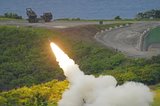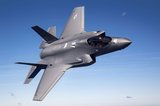Pentagon grounds global fleet of F-35s after crash
The Pentagon grounded the global fleet of F-35 stealth fighters on 11 October, as a result of the first ever crash of the costliest plane in history.
A Marine Corps F-35B was completely destroyed in a crash during training in South Carolina on 28 September. The pilot safely ejected.
According to Joe DellaVedova, a spokesman for the F-35 programme, the US and its international partners - including Britain and Israel - have temporarily suspended F-35 flight operations for a fleet-wide inspection of a fuel tube within the engine on all F-35 aircraft.
'The action to perform the inspection is driven from initial data from the ongoing investigation of the F-35B that crashed in the vicinity of Beaufort, South Carolina,' DellaVedova said in a statement.
He added that suspect fuel tubes would be removed and replaced. If good tubes are already installed, then those planes would be returned to operational status.
Inspections were expected to be completed within the next 24 to 48 hours.
Britain, however, said the measure did not affect all of its F-35s, and that some flying missions had been 'paused,' not grounded.
'Safety is our paramount concern, therefore the UK has decided to pause some F-35 flying as a precautionary measure while we consider the findings of an ongoing enquiry,' a British Ministry of Defence spokesman said.
'F-35 flight trials from the aircraft carrier HMS Queen Elizabeth are continuing and the programme remains on schedule to provide our armed forces with a game-changing capability.'
The South Carolina crash came only one day after the US military first used the F-35 in combat, when USMC fighters hit Taliban targets in Afghanistan.
'The primary goal following any mishap is the prevention of future incidents,' DellaVedova said.
'We will take every measure to ensure safe operations while we deliver, sustain and modernise the F-35.'
On 10 October Defense News reported that US Defence Secretary Jim Mattis had ordered the air force and navy to make 80% of the fleet of key fighters, including the F-35, mission capable within a year.
The order sent ripples through the halls of the Pentagon, where officials have long bemoaned a general lack of readiness for key equipment.
Launched in the early 1990s, the F-35 programme is considered the most expensive weapons system in US history, with an estimated cost of some $400 billion and a goal to produce 2,500 aircraft in the coming years.
Once servicing and maintenance costs for the F-35 are factored in over the aircraft's lifespan through 2070, overall programme costs are expected to rise to $1.5 trillion.
Proponents tout the F-35's radar-dodging stealth technology, supersonic speeds, close air support capabilities, airborne agility and a massive array of sensors giving pilots unparalleled access to information.
But the programme has faced numerous delays, cost overruns and setbacks, including a mysterious engine fire in 2014 that led commanders to temporarily ground the planes.
So far, the US military has taken delivery of 245 F-35s, most of them to the air force.
More from Defence Notes
-
![Taiwan approved for purchase of $11 billion in weapons from US]()
Taiwan approved for purchase of $11 billion in weapons from US
The US State Department’s approval of a multi-billion-dollar sale of weapons to Taiwan includes tactical mission networks equipment, uncrewed aerial systems, artillery rocket systems and self-propelled howitzers as well as anti-tank guided missiles.
-
![US National Security Strategy prioritises advanced military capabilities and national industry]()
US National Security Strategy prioritises advanced military capabilities and national industry
The 2025 NSS has emphasised investment in the US nuclear and air defence inventory and national industry, but it leaves multiple unanswered questions on how the White House will implement this approach.
-
![Canada set to look away from its neighbour and across the Atlantic for partners]()
Canada set to look away from its neighbour and across the Atlantic for partners
While non-EU UK struggles to join the Security Action for Europe initiative, which provides loans for defence programmes, Canada has become the first country outside Europe to get access – and did so for a nominal fee.
-
![NATO experiments with solutions to integrate networks, AI and uncrewed systems]()
NATO experiments with solutions to integrate networks, AI and uncrewed systems
During the latest edition of the NATO DiBaX, the alliance tested multiple capabilities to inform requirements for future efforts.
























